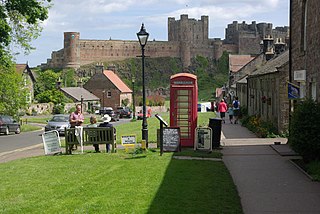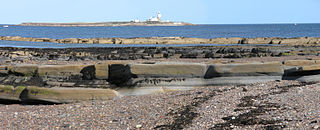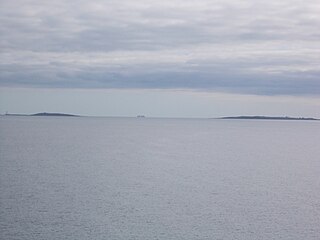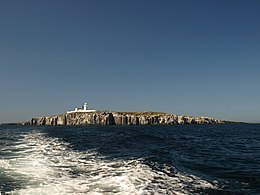
Lindisfarne, also called Holy Island, is a tidal island off the northeast coast of England, which constitutes the civil parish of Holy Island in Northumberland. Holy Island has a recorded history from the 6th century AD; it was an important centre of Celtic Christianity under Saints Aidan, Cuthbert, Eadfrith, and Eadberht of Lindisfarne. The island was originally home to a monastery, which was destroyed during the Viking invasions but re-established as a priory following the Norman Conquest of England. Other notable sites built on the island are St. Mary the Virgin parish church, Lindisfarne Castle, several lighthouses and other navigational markers, and a complex network of lime kilns. In the present day, the island is an Area of Outstanding Natural Beauty and a hotspot for historical tourism and bird watching. As of February 2020, the island had three pubs, a hotel and a post office.

Cuthbert of Lindisfarne was an Anglo-Saxon saint of the early Northumbrian church in the Celtic tradition. He was a monk, bishop and hermit, associated with the monasteries of Melrose and Lindisfarne in the Kingdom of Northumbria, today in north-eastern England and south-eastern Scotland. Both during his life and after his death, he became a popular medieval saint of Northern England, with a cult centred on his tomb at Durham Cathedral. Cuthbert is regarded as the patron saint of Northumbria. His feast days are 20 March and 4 September.

Bamburgh is a village and civil parish on the coast of Northumberland, England. It had a population of 454 in 2001, decreasing to 414 at the 2011 census.

Grace Horsley Darling was an English lighthouse keeper's daughter. Her participation in the rescue of survivors from the shipwrecked Forfarshire in 1838 brought her national fame. The paddlesteamer ran aground on the Farne Islands off the coast of Northumberland in northeast England; nine members of the crew were saved.

Seahouses is a large village on the North Northumberland coast in England. It is about 20 kilometres (12 mi) north of Alnwick, within the Northumberland Coast Area of Outstanding Natural Beauty.

The common eider, also called St. Cuthbert's duck or Cuddy's duck, is a large sea-duck that is distributed over the northern coasts of Europe, North America and eastern Siberia. It breeds in Arctic and some northern temperate regions, but winters somewhat farther south in temperate zones, when it can form large flocks on coastal waters. It can fly at speeds up to 113 km/h (70 mph).

Coquet Island is a small island of about 6 hectares, situated 1.2 kilometres (0.75 mi) off Amble on the Northumberland coast, northeast England. It is included in the civil parish of Hauxley.

The Copeland Islands is a group of three islands in the north Irish Sea, north of Donaghadee, County Down, Northern Ireland, consisting of Lighthouse Island, Copeland Island and Mew Island. They lie within the civil parish of Bangor.
Lady Isle is a small, uninhabited island, in the Firth of Clyde, Scotland. It was once home to a chapel dedicated to Saint Mary. The island features a lighthouse and a freshwater spring.

Beadnell is a village and civil parish in Northumberland, England. It is situated about 4 miles (6.4 km) south-east of Bamburgh, on the North Sea coast, and has a population of 528(2001), increasing to 545 at the 2011 Census. It takes its name from the Anglo Saxon "Bede's Hall". The earliest written reference is found in 1161.
This timeline summarises significant events in the history of Northumbria and Northumberland.

Forfarshire was a paddle steamer with brigantine rigging, built in Dundee in 1834, and which struck and later foundered on one of the Farne Islands on 7 September 1838, giving rise to the rescue for which Grace Darling is famed.

Staple Island is a small rocky island, or skerry, that is one of the Outer Group of the Farne Islands in Northumberland, England. The Farne Islands are a designated National Nature Reserve. Staple Island is an important wildlife habitat known for its prolific breeding colonies of Atlantic puffins, razorbills and kittiwakes. A notable colony of grey seals breeds on the island with pups born every year in September–November.
St Cuthbert's Cave, known locally as Cuddy's Cave or Cove, can refer to one of two natural sandstone caves in Northumberland, England, that have been traditionally associated with Saint Cuthbert, the 7th-century Anglo-Saxon monk, bishop and hermit.

Longstone Lighthouse is an active 19th century lighthouse located on Longstone Rock in the outer group of the Farne Islands off the Northumberland Coast, England. Completed in 1826, it was originally called the Outer Farne Lighthouse, and complemented the earlier Inner Farne Lighthouse. The lighthouse is best known for the 1838 wreck of the Forfarshire and the role of Grace Darling, the lighthouse keeper's daughter, in rescuing survivors.
SS Abessinia, a German cargo ship, was built in 1900, by Palmers Shipbuilding & Iron Co. of Newcastle. Constructed of steel and measuring 137.6m x 15.8m x 8.5m she was 5753 gross register tons and was equipped with a triple expansion engine & three boilers giving 642 horse power and a speed of 12 1⁄2 knots. Owned by the Hamburg-America Line she was interned by Chile during the war and her machinery damaged by her crew.

The Natural History Society of Northumbria (NHSN) is a voluntary organization to promote the study of natural history and protect the wildlife of North East England.

Bamburgh Lighthouse was built by Trinity House in 1910 to guide shipping both passing along the Northumberland coast and in the waters around the Farne Islands. It was extensively modernised in 1975 and is now monitored from the Trinity House Operations and Planning Centre in Harwich. Routine maintenance is carried out by a local attendant. It is the most northerly land-based lighthouse in England.

Farne Lighthouse is a lighthouse on the southern tip of Inner Farne. Built in the early 19th century, it still functions as a lighthouse and is managed by Trinity House. In 1910 it was one of the first Trinity House lighthouses to be automated.

The Monument to Grace Darling, in the churchyard of St Aidan's Church, Bamburgh, Northumberland is a Victorian Gothic memorial. The monument was designed by Anthony Salvin, with later renovations by Frederick Wilson, C. R. Smith and W. S. Hicks. Grace Darling was born on 24 November 1815, the daughter of the lighthouseman at Longstone Lighthouse. In 1838, Darling became a national heroine when she and her father rescued nine people from the wreck of the SS Forfarshire, a ship that had run aground off Big Harcar, an island off the Northumbrian coast. Darling died of tuberculosis aged 26 in 1842, and the monument was raised some distance to the north of her grave to make it visible to passing sailors, at the west edge of the churchyard in the same year. It is a Grade II* listed structure.
























